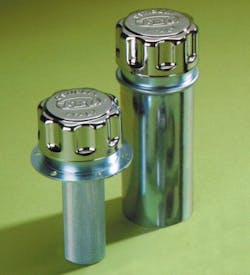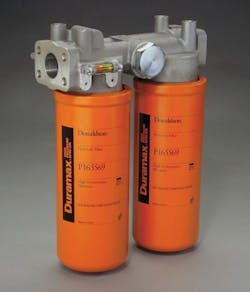Any industrial hydraulic circuit can benefit from the generous application of filters. However, cost and other factors, such as available space, limit the number of filters that can be specified for any given system. The best systems, then, are strategically engineered to ensure that fluid is filtered properly at each stage of its journey through the circuit. Ideally, filtration should be provided in the reservoir, before and after the pump, in return lines, and off-line. Again, though, cost generally prohibits implementing filtration systems as extensive as this.
In reality, designers have to make tough decisions about which filters they can afford and which ones they can do without. The extent of filtration depends on:
So when specifying the ideal hydraulic filtration circuit just isn’t an option, determining which filters will do the greatest good for an application (and for the least amount of money) becomes the task at hand. Following are some general cost-versus-benefit guidelines to help you make this determination.
Breather filters are placed on hydraulic reservoirs to prevent atmospheric contamination from entering. Air enters the reservoir whenever the fluid level drops. This occurs during normal cycling of the machine, and when fluid cools down during idle periods. Breathers are designed to stop particles larger than 3 µm from entering the system. This is a sensible, affordable solution for any hydraulic system, but by all means cannot be the only filter on a hydraulic system.
*Cost: $10 to $15 Benefit: high
Suction strainers, or sump-type filters, are typically found in the hydraulic fluid reservoir. Their only real use is to keep cigarette butts, moths, nuts and bolts, and the like out of the pump. These large size contaminants easily can be eliminated instead by keeping the reservoir sealed and by using a filler-breather and return-line filter. However, no matter how unlikely it may seem that large objects such as these could find their way into a hydraulic reservoir, the potential does exist. So the low cost of a suction strainer could prevent extensive damage to an expensive hydraulic pump (not to mention the cost of downtime).
*Cost: $10 to $15 Benefit: medium
Suction filters, normally placed between the reservoir and the pump, are designed to remove particles sized from 5 to 150 µm. They are easier to service and less expensive than many other types of filters. However, to prevent restricting the pump’s suction line (which could cause cavitation), they tend to be substantially larger than similar return or pressure filters with the same flow rating.
Contaminants other than dirtExcessive water in a hydraulic system can be just as detrimental as excessive dirt. Water often enters a hydraulic system when humid air is drawn into the reservoir through the filter breather. Water-removal elements can be specified to remove water from the hydraulic fluid, but better still is to keep the water from entering in the first place. To keep water from entering the reservoir, filter breathers containing a desiccant can be specified. The desiccant, which must be replaced periodically, absorbs moisture from the air as it is drawn into the reservoir. Another alternative is a reservoir sealed from the atmosphere by using a balloon-type bladder that contains the air as it is drawn in. Air bubbles suspended in the hydraulic fluid are also undesirable. Air drawn into the pump can cause it to cavitate, which will cause rapid wear and drastically shorten pump life. Reservoirs, baffles, and return lines should be designed to prevent the formation of foam and bubbles. But for added protection, a diffuser can be positioned near return lines to break up bubbles as they enter the reservoir. A diffuser is a screen positioned about 45° from horizontal. As fluid passes through the screen, bubbles collect on the mesh and collide with each other to form larger bubbles. These larger bubbles then rise to the surface of the fluid and will not be drawn into the suction line, which should be positioned near the bottom of the reservoir. Flow diffusers are becoming more popular as reservoirs become smaller. In the past, large reservoirs were specified to provide plenty of time for entrained air to rise to the fluid surface. With smaller reservoirs, however, fluid spends less time in the reservoir, so there is less time for air to rise to the surface. |
The most popular application of suction filters is on variable-speed hydrostatic drives, usually found in mobile equipment and some industrial drives. They also are often used with charge pumps.
*Cost: $50 to $500 Benefit: medium
Off-line filters, sometimes referred to as kidney loops, can achieve very fine filtration by maintaining steady-state flow that can filter fluid whether the main hydraulic system is running or not. (Kidney-loop circuits often contain a heat exchanger to keep hydraulic fluid within an optimum temperature range.) The entire hydraulic system can keep operating while the kidney loop filter is being serviced, or the kidney loop can clean the fluid in the reservoir while the hydraulic system is shut down.
A kidney loop draws fluid from the reservoir, pumps it through its low-pressure filters, and returns it to the reservoir. Filter elements in a kidney loop are easy to reach, so they are more likely to be maintained than filters placed in hard-to-reach areas of the machine. Kidney-loop filters can either be integrated into the main hydraulic reservoir, or they can be incorporated into a mobile filter cart for servicing many hydraulic systems.
This type of filtration presents opportunities for creative and economical application. For example, a kidney loop running all night can remove an enormous amount of contamination from the reservoir, which will extend the life of all the filters in the hydraulic circuit. Or a filter cart can clean fluid overnight in one system, be moved to another machine to filter its fluid all day, then moved to a third machine for overnight filtration.
Unfortunately, kidney loop filters do not directly protect components. Their main function is to thoroughly clean the hydraulic fluid. Also, most filter carts require an electric or air motor to drive their circulating pump, so they can be used only where an external source of power is nearby.
*Cost: $300 to $1500 Benefit: high
...continued
Return line filters usually have low-pressure housings, which are less expensive than their high-pressure counterparts. Return-line filters collect contaminants from the oil as it returns to the reservoir. Much like the kidney loop, return-line filters are versatile. They can be positioned almost anywhere within the return line circuit, either mounted inline or built into the reservoir.
Disadvantages are few, but worth noting. Return-line filters can be sensitive to flow surges that can degrade their performance. These surges can be caused by multiple valves shifting simultaneously or from flow intensification from cylinders. This means it is important to size return-line filters for maximum anticipated flow.
Return-line filters also do not clean fluid entering the reservoir through drain lines. Although return filters are widely used, few standards exist to regulate consistency from one manufacturer to another. This means that replacement cartridges from sources other than the original may not be completely interchangeable.
Return-line and kidney-loop filters offer great value and are easy to maintain. They are available in a wide variety of media choices, making them suitable for most industrial applications.
*Cost: $30 to $1000 Benefit: high
High-pressure filters, sometimes called last-chance filters, clean the fluid delivered by the pump. This protects expensive downstream components, such as servovalves and actuators. High-pressure filters offer protection from catastrophic pump failure and are a worthwhile investment for high-performance systems. They find wide application in aircraft, paper and steel mills, and injection molding and die-casting machines.
One disadvantage of high pressure filters is, ironically, the high pressure. Housings for these filters must withstand pressures of 6000 psi or higher, so they can be heavy and difficult to handle — as anyone who has ever tried to change a slippery, 200-lb cast-iron filter can attest. Unless a duplex configuration is used and strict safety practices followed, the entire hydraulic system must be shut down to service a high-pressure filter.
*Cost: $200 to $2500 Benefit: high
Evaluate costs and benefits
Deciding which of these filtration techniques are essential, and which you can do without, requires careful study of the application at hand. Historical data and experience are some of the best tools to aid in making this decision. For new applications, as much data as time allows should be collected and studied. This should include the amount and nature of contamination anticipated as well as the operating conditions of the hydraulic system.
Curt Rausch is Industrial Hydraulics Product Manager, Donaldson Co., Inc., Minneapolis. Click here to visit Donaldson's Industrial Hydraulics Filtration website.
*Prices mentioned above may vary due to the economic changes since this article was originally published.






